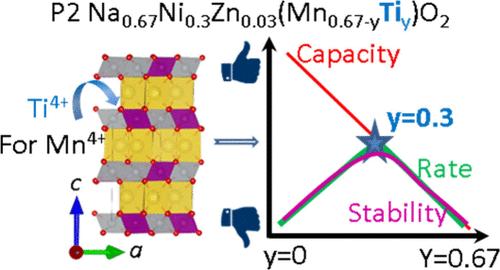当前位置:
X-MOL 学术
›
Chem. Mater.
›
论文详情
Our official English website, www.x-mol.net, welcomes your
feedback! (Note: you will need to create a separate account there.)
Optimal Ti-Substitution in Layered Oxide Cathodes for Na-Ion Batteries
Chemistry of Materials ( IF 7.2 ) Pub Date : 2024-10-30 , DOI: 10.1021/acs.chemmater.4c02501 Elisa Grépin, Yue Zhou, Biao Li, Gwenaëlle Rousse, Jean-Marie Tarascon, Sathiya Mariyappan
Chemistry of Materials ( IF 7.2 ) Pub Date : 2024-10-30 , DOI: 10.1021/acs.chemmater.4c02501 Elisa Grépin, Yue Zhou, Biao Li, Gwenaëlle Rousse, Jean-Marie Tarascon, Sathiya Mariyappan

|
Sodium layered oxides NaxMO2 (x ≤ 1 and M = transition metal ions) gain interest as sodium-ion battery (NIB) cathodes due to their high energy density and cost-effectiveness. The nature of transition metal ions (M) defines the material properties, and the substitution of M with redox inactive Ti4+ is often seen as beneficial in reducing phase transitions during cycling and thus improving the cycle life. In this respect, our present study focuses on understanding the origin of this improvement by studying the highly substituted P2 Na0.67Ni0.30Zn0.03Mn0.67–yTiyO2 (0 ≤ y ≤ 0.67) phases based on their electrochemical performance combined with structural analyses and DFT calculations. The results indicate that Ti4+, by increasing the M–O bond ionicity, disrupts the Na+-vacancy ordering at lower voltages (<4 V, until ∼60% SOC) and reduces the participation of O 2p in the redox process, thereby suppressing Na-removal and the extent of P2–O2 phase transition at high voltages. We show that this effect becomes maximum for y = 0.52 (P2 Na0.67Ni0.30Zn0.03Mn0.15Ti0.52O2) and beyond, for which we observe a nearly solid-solution-like behavior of the P2-type structure. However, the d0 Ti4+ is prone to cation migration leading to poor structural reversibility as observed from operando XRD analyses, making the highly Ti4+-substituted material less suitable for practical applications. An optimum ratio of y = 0.3 (Na0.67Ni0.3Zn0.03Mn0.37Ti0.3O2) is beneficial for the cycle life as well as rate capability, and the study points to the importance of carefully selecting transition metal combinations in the finest ratio to achieve the best performing sodium layered oxide electrode materials.
中文翻译:

钠离子电池层状氧化物阴极中的最佳钛取代
钠层状氧化物 NaxMO2(x ≤ 1 和 M = 过渡金属离子)因其高能量密度和成本效益而成为钠离子电池 (NIB) 阴极而受到关注。过渡金属离子 (M) 的性质决定了材料的性能,用氧化还原非活性 Ti4+ 取代 M 通常被认为有利于减少循环过程中的相变,从而提高循环寿命。在这方面,我们本研究的重点是通过研究高度取代的 P2 Na0.67Ni0.30Zn0.03Mn0.67–yTiyO2 (0 ≤ y ≤ 0.67) 相来了解这种改进的起源基于它们的电化学性能,结合结构分析和 DFT 计算。结果表明,Ti4+ 通过增加 M-O 键离子度,破坏了较低电压(<4 V,直到 ∼60% SOC)下的 Na+-空位排序,并减少了 O 2p 在氧化还原过程中的参与,从而抑制了 Na 去除和高压下 P2-O2 相变的程度。我们表明,当 y = 0.52 (P2 Na0.67Ni0.30Zn0.03Mn0.15Ti0.52O2) 及更高时,这种效应变得最大,为此我们观察到 P2 型结构的近乎固溶体的行为。然而,从原位 XRD 分析中观察到的 d0 Ti4+ 容易发生阳离子迁移,导致结构可逆性差,这使得高度 Ti4+ 取代的材料不太适合实际应用。最佳比率 y = 0.3 (Na0.67Ni0.3Zn0.03Mn0.37Ti0.3O2) 有利于循环寿命和倍率能力,并且该研究指出了以最佳比例仔细选择过渡金属组合以实现最佳性能钠层状氧化物电极材料的重要性。
更新日期:2024-10-30
中文翻译:

钠离子电池层状氧化物阴极中的最佳钛取代
钠层状氧化物 NaxMO2(x ≤ 1 和 M = 过渡金属离子)因其高能量密度和成本效益而成为钠离子电池 (NIB) 阴极而受到关注。过渡金属离子 (M) 的性质决定了材料的性能,用氧化还原非活性 Ti4+ 取代 M 通常被认为有利于减少循环过程中的相变,从而提高循环寿命。在这方面,我们本研究的重点是通过研究高度取代的 P2 Na0.67Ni0.30Zn0.03Mn0.67–yTiyO2 (0 ≤ y ≤ 0.67) 相来了解这种改进的起源基于它们的电化学性能,结合结构分析和 DFT 计算。结果表明,Ti4+ 通过增加 M-O 键离子度,破坏了较低电压(<4 V,直到 ∼60% SOC)下的 Na+-空位排序,并减少了 O 2p 在氧化还原过程中的参与,从而抑制了 Na 去除和高压下 P2-O2 相变的程度。我们表明,当 y = 0.52 (P2 Na0.67Ni0.30Zn0.03Mn0.15Ti0.52O2) 及更高时,这种效应变得最大,为此我们观察到 P2 型结构的近乎固溶体的行为。然而,从原位 XRD 分析中观察到的 d0 Ti4+ 容易发生阳离子迁移,导致结构可逆性差,这使得高度 Ti4+ 取代的材料不太适合实际应用。最佳比率 y = 0.3 (Na0.67Ni0.3Zn0.03Mn0.37Ti0.3O2) 有利于循环寿命和倍率能力,并且该研究指出了以最佳比例仔细选择过渡金属组合以实现最佳性能钠层状氧化物电极材料的重要性。


















































 京公网安备 11010802027423号
京公网安备 11010802027423号